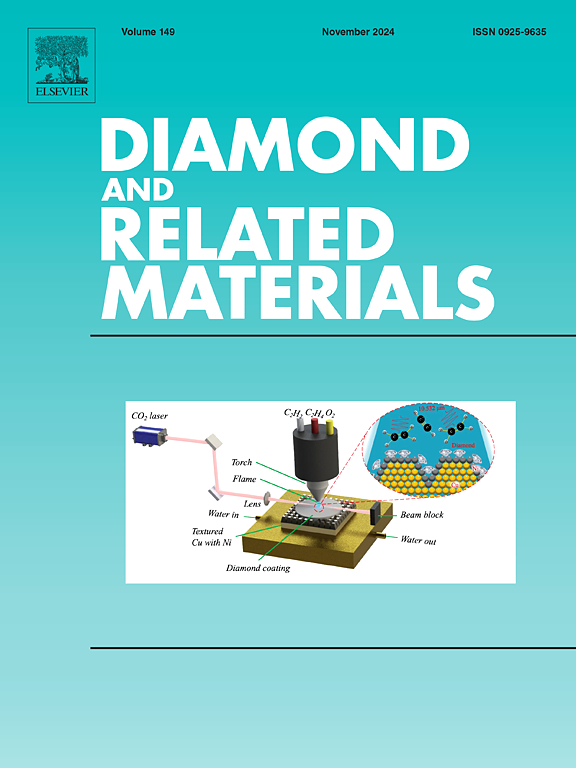含氧化石墨烯-银纳米颗粒的互穿聚乙烯醇水凝胶:体外生物相容性和抗菌性能
IF 5.1
3区 材料科学
Q2 MATERIALS SCIENCE, COATINGS & FILMS
引用次数: 0
摘要
将银(Ag)和还原氧化石墨烯(rGO)纳米粒子(NPs)整合到聚乙烯醇(PVA)聚合物基体中,制备纳米复合材料。采用水热法一步合成还原氧化石墨烯和AgNO3,制备还原氧化石墨烯- ag纳米粒子。在此基础上合成了rGO、rGO-Ag NPs、PVA- g和PVAAgG水凝胶,PVA在石墨烯和Ag NPs之间起到结合剂的作用。各种分析方法证实,银纳米粒子沉积在氧化石墨烯上具有很强的物理相互作用。此外,通过负载石墨烯和rGO-Ag NPs (PVAAgG)水凝胶制备了水凝胶,证明了材料的完整性和稳定性。高分辨率透射电镜(HR-TEM)研究了制备的小尺寸Ag NPs(约7-9 nm),其晶体结构和热性能得到了改善,并通过差示扫描量热法(DSC)分析得到了证实。扫描电镜(SEM)分析表明,水凝胶形成的孔隙规则且均匀。经能谱分析证实,水凝胶的含量分布一致。此外,PVA-AgG水凝胶与L929成纤维细胞具有良好的生物相容性,对大肠杆菌、金黄色葡萄球菌和奇迹变形杆菌具有良好的抗菌活性。该PVA-AgG水凝胶在改善纤维网络性能和解决目前生物活性伤口敷料开发中的问题方面具有很大的潜力。本文章由计算机程序翻译,如有差异,请以英文原文为准。

Interpenetrating PVA hydrogels with rGO-Ag nanoparticles: In vitro biocompatibility and antibacterial properties
Silver (Ag) and reduced graphene oxide (rGO) nanoparticles (NPs) were integrated into a polyvinyl alcohol (PVA) polymer matrix to develop nanocomposites. In a single step, rGO and AgNO3 were synthesized using the hydrothermal method to make rGO-Ag NPs, which were subsequently incorporated. Based on that, rGO, rGO-Ag NPs, PVA-G, and PVA![]() AgG hydrogels were synthesized, and PVA plays the role of a binding agent between graphene and Ag NPs. Various analytical methods confirmed that the Ag NPs deposited on rGO with strong physical interactions. Further, the hydrogels were fabricated by loading with graphene and rGO-Ag NPs (PVA
AgG hydrogels were synthesized, and PVA plays the role of a binding agent between graphene and Ag NPs. Various analytical methods confirmed that the Ag NPs deposited on rGO with strong physical interactions. Further, the hydrogels were fabricated by loading with graphene and rGO-Ag NPs (PVA![]() AgG) hydrogels, proving that the materials are intact and stable. The high-resolution transmission electron microscopy (HR-TEM) study explored the prepared small-sized Ag NPs (approximately 7–9 nm) with a crystalline structure and improved thermal properties, which is proved by differential scanning calorimetry (DSC) analysis. The scanning electron microscopy (SEM) showed that the hydrogel formed with regular pores and was uniform. The hydrogel's contents were consistently distributed, as confirmed by elemental analysis using energy dispersive spectroscopy (EDS). In addition, the PVA-AgG hydrogel demonstrated biocompatibility with L929 fibroblast cells and superior antibacterial activity against Escherichia coli, Staphylococcus aureus, and Proteus mirabilis. This PVA-AgG hydrogel has great potential to improve fibrous network performance and solve present issues in the development of bioactive wound dressings.
AgG) hydrogels, proving that the materials are intact and stable. The high-resolution transmission electron microscopy (HR-TEM) study explored the prepared small-sized Ag NPs (approximately 7–9 nm) with a crystalline structure and improved thermal properties, which is proved by differential scanning calorimetry (DSC) analysis. The scanning electron microscopy (SEM) showed that the hydrogel formed with regular pores and was uniform. The hydrogel's contents were consistently distributed, as confirmed by elemental analysis using energy dispersive spectroscopy (EDS). In addition, the PVA-AgG hydrogel demonstrated biocompatibility with L929 fibroblast cells and superior antibacterial activity against Escherichia coli, Staphylococcus aureus, and Proteus mirabilis. This PVA-AgG hydrogel has great potential to improve fibrous network performance and solve present issues in the development of bioactive wound dressings.
求助全文
通过发布文献求助,成功后即可免费获取论文全文。
去求助
来源期刊

Diamond and Related Materials
工程技术-材料科学:综合
CiteScore
6.00
自引率
14.60%
发文量
702
审稿时长
2.1 months
期刊介绍:
DRM is a leading international journal that publishes new fundamental and applied research on all forms of diamond, the integration of diamond with other advanced materials and development of technologies exploiting diamond. The synthesis, characterization and processing of single crystal diamond, polycrystalline films, nanodiamond powders and heterostructures with other advanced materials are encouraged topics for technical and review articles. In addition to diamond, the journal publishes manuscripts on the synthesis, characterization and application of other related materials including diamond-like carbons, carbon nanotubes, graphene, and boron and carbon nitrides. Articles are sought on the chemical functionalization of diamond and related materials as well as their use in electrochemistry, energy storage and conversion, chemical and biological sensing, imaging, thermal management, photonic and quantum applications, electron emission and electronic devices.
The International Conference on Diamond and Carbon Materials has evolved into the largest and most well attended forum in the field of diamond, providing a forum to showcase the latest results in the science and technology of diamond and other carbon materials such as carbon nanotubes, graphene, and diamond-like carbon. Run annually in association with Diamond and Related Materials the conference provides junior and established researchers the opportunity to exchange the latest results ranging from fundamental physical and chemical concepts to applied research focusing on the next generation carbon-based devices.
 求助内容:
求助内容: 应助结果提醒方式:
应助结果提醒方式:


